 Loading... Please wait...
Loading... Please wait...-
Call us at: 941-500-2288
-
Mail Us at: Trains N Scale P.O. Box 178 Lehigh Acres, FL 33970-0178
- My Account
- Items / $0.00
All prices are in All prices are in USD
Categories
- Home
- Models and Prototypes Blog
- It's Been 150 Years Since America's 1st Transcontinental Railroad Was Completed
It's Been 150 Years Since America's 1st Transcontinental Railroad Was Completed
Posted by Neville C. Wilson on 7th May 2019
The 150th anniversary (sesquicentennial) celebration of the "Last Spike" ceremony that commemorated the completion of the "Pacific Railroad" (later called the "Overland Route"), America's First Transcontinental Railroad, occurs on May 10, 2019.
Commencing in January 1863, heading east, the Central Pacific Railroad Company began laying track from Sacramento, California, while eighteen months later, in July 1865, the Union Pacific Railroad headed west, from Council Bluffs, Iowa, which is near Omaha, Nebraska.
Despite unforeseen delays brought on by Civil War reconstruction efforts and fierce and sometimes unproductive competition between the pair of railway companies, the east and westbound tracks were eventually joined at Promontory Summit, Utah Territory.
To acknowledge the significant American achievement, lead by Central Pacific's No. 60 "Jupiter" and the Union Pacific's No. 119, two trans of dignitaries were dispatched to Promontory Summit to commemorate the railway's completion.
Symbolizing the linking of America's East and West by rail, the aforementioned pair of 4-4-0 steam locomotives were posed and photographed nose-to-nose during the May 10, 1869 event.
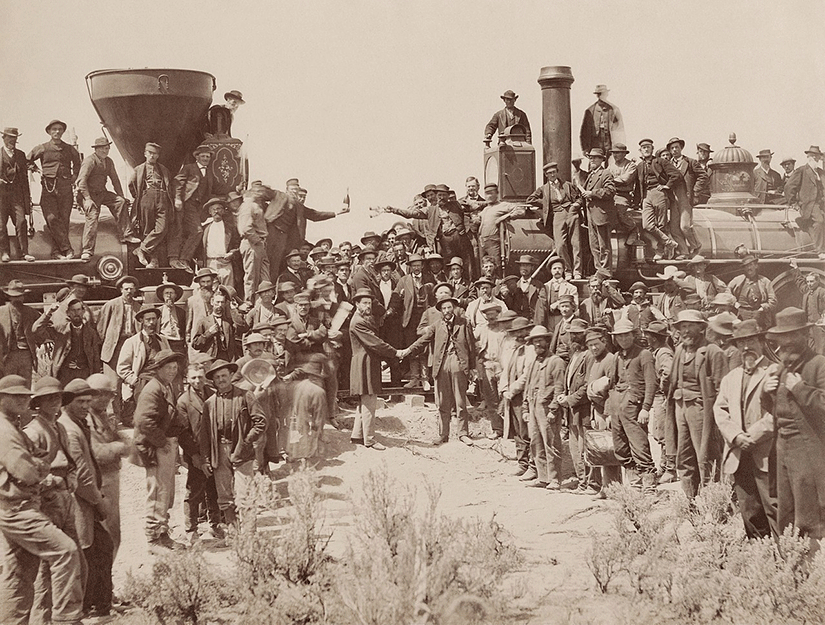
Andrew Joseph Russell (1830-1902) stereoviw image of the Promontory Summit, Utah Territory celebration that was taken after the driving of the ceremonial last spike.
Central Pacific Chief Engineer (center left) Samuel Skerry Montague (1830-1883) is seen shaking hands with Union Pacific Chief Engineer (center right) Grenville Mellen Dodge (1831-1916).
Following speeches and the presentation of commemorative spikes to the Central Pacific's remaining three "Big Four" (a moniker that was bestowed upon the four businessmen, philanthropists and railroad tycoons who established the Central Pacific Railroad) associates, Collis Potter Huntington (1821–1900), Mark Hopkins (1813–1878), and Charles Crocker (1822–1888) who were not in attendance, with a silver spike maul, business tycoon, industrialist, politician, Stanford University founder, "Big Four" member, and the President of the Southern Pacific and Central Pacific Railroads, Amasa Leland Stanford (1824-1893) tapped a 17.6-karat gold ceremonial "Last Spike" into a pre-bored hole in a polished ceremonial California laurel wood tie.
Upon the event's conclusion, the symbolic gold spike and the laurel wood tie were removed and replaced with a standard iron spike and an ordinary wood tie..
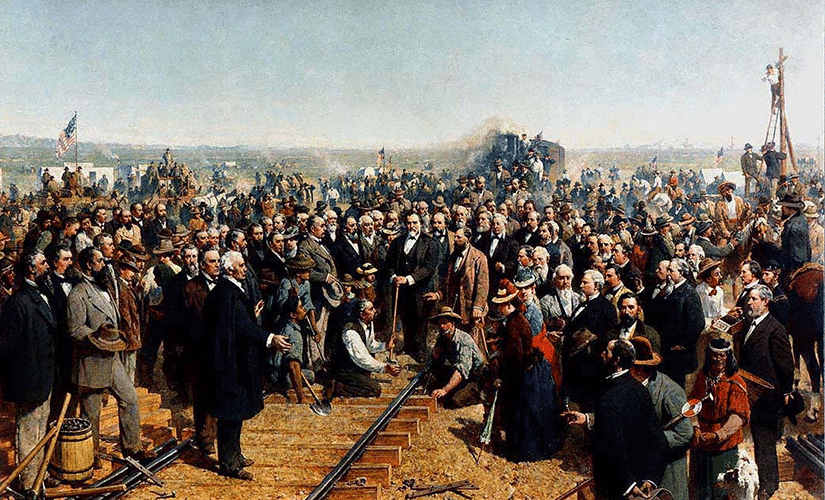
"The Last Spike" - An 1881 Painting by Thomas Hill (1829–1908) - California State Railroad Museum
Currently part of the Stanford Family Collection at Stanford University's Cantor Arts Center, the "Last Spike" was donated to the Stanford Museum in 1898.
Engraved on four sides and bearing the date May 8, 1869 (which if not for unforeseen inclement weather and a labor dispute, was to have been the actual celebration day), the 14.03 troy once ceremonial spike was cast in 73% copper-alloyed-gold.
Retained by San Francisco contractor and financier David Hewes (1822-1915) family until 2005, fabricated at the same time as the first, a second spike (which is often referred to as the "Lost Spike") bears the actual date of the event, May 10, 1869..
Responsible for donating and ordering the gold "Last Spike" from San Francisco's William T. Garrett Foundry and facilitating Western Union's transmission of the silver maul's taps, which were heard coast-to-coast in the form of clicks, Hewes (Leland Stanford’s brother-in-law) was an ardent supporter of the construction and completion of America's First Transcontinental Railroad.
Both Thomas Hill's 1881 painting "The Last Spike" and the Hewes family spike are currently exhibited at Sacramento's California State Railroad Museum.
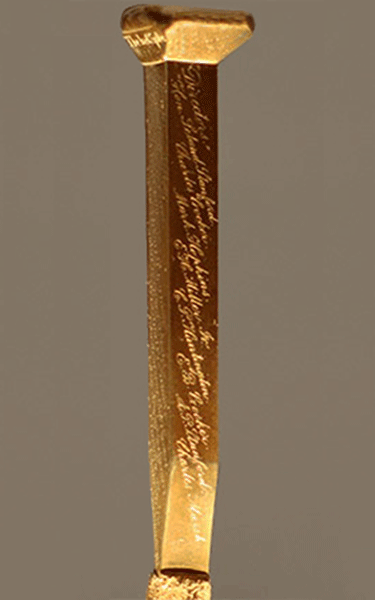
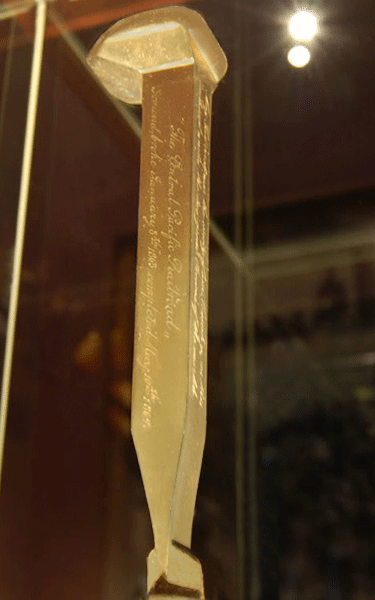
David Hewes (1822-1915) Family "Lost Spike" - California State Railroad Museum
While the event at Promontory Summit marked the completion of the first 1,912-mile long transcontinental railroad line, until one was established through the connection of the Kansas Pacific and Denver Pacific railways at Strasburg, Colorado in August 1870, merely linking Omaha to Sacramento did not create a continuous rail network that would connect America's Atlantic and Pacific coasts.
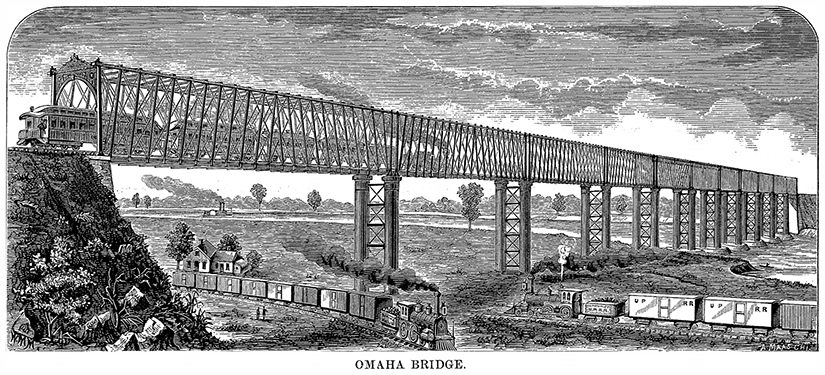 The American Bridge Company Omaha Bridge Pages 22 - 23 - 1874. The Railroad Gazette, New York Google Books
The American Bridge Company Omaha Bridge Pages 22 - 23 - 1874. The Railroad Gazette, New York Google Books
Following the city's devastating 1906 earthquake, the commemorative last laurel tie was lost in the fires that consumed San Francisco.
Built by New York's Schenectady Locomotive Works in September 1868 and returned to revenue service following the Golden Spike Ceremony, the prototype Central Pacific No. 60 Jupiter 4-4-0 steam locomotive was scrapped in 1909.
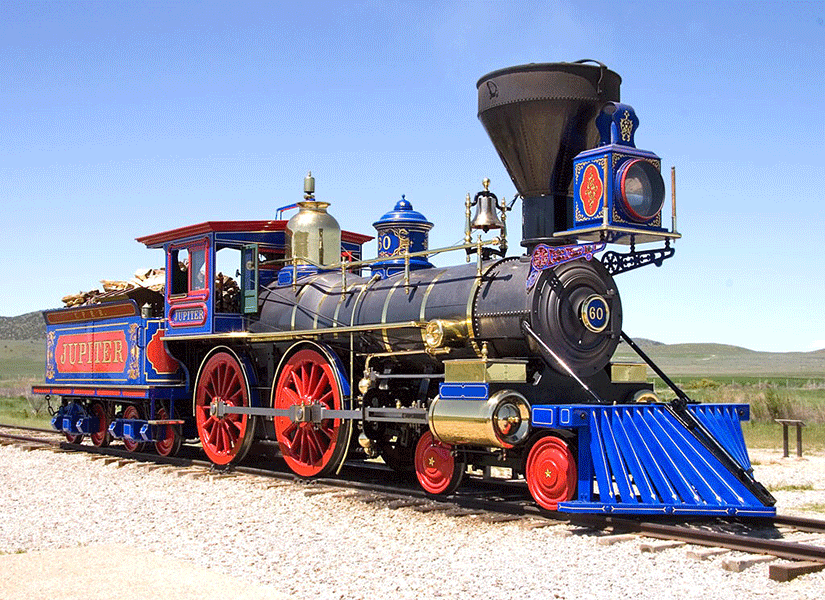
1979 O'Connor Engineering Replica of Central Pacific 60 Jupiter - Golden Spike National Historical Park Utah
Constructed by Patterson, New Jersey's Rodgers Locomotive and Machine Works in 1890 and returned to freight service following the Golden Spike Ceremony, the prototype Union Pacific No. 119 4-4-0 steam locomotive was scrapped in 1903, long before it and the Central Pacific No. 60 Jupiter's historical significance were recognized.
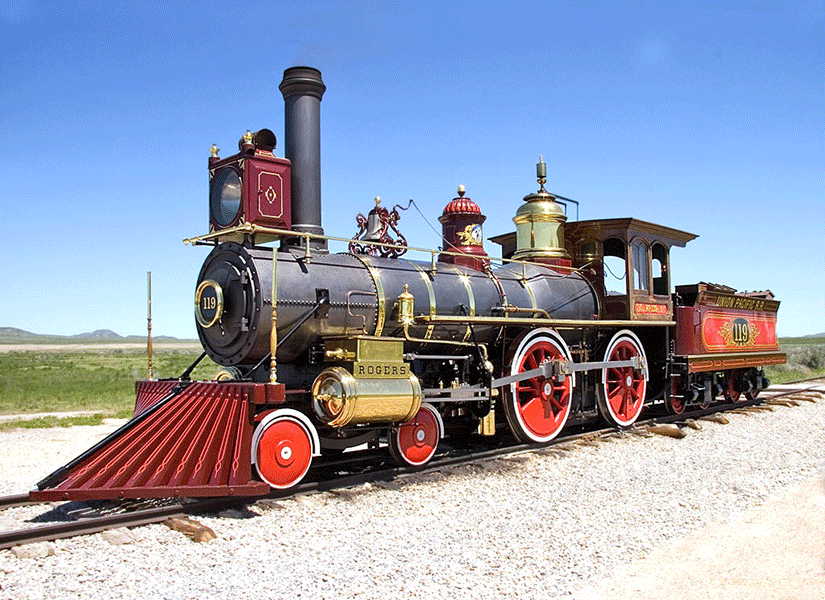
1979 O'Connor Engineering Replica of Union Pacific 119 - Golden Spike National Historical Park Utah
Avoiding curves and grades, while shortening the route by 43 miles, mainline trains no longer climbed Promontory Summit once the Lucin Cutoff (which crosses the Great Salt Lake in between Ogden and Lucin) was constructed in 1904.
Bypassed by the aforementioned track relocation, begun with a ceremonial "undriving" of the Last Iron Spike (which replaced the ceremonial golden spike), the old summit rails were removed in 1942 and recycled as part of the American war effort.
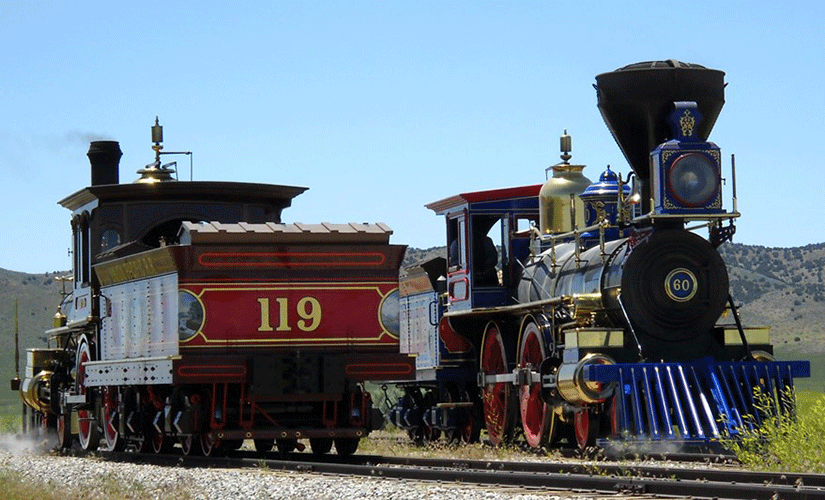
Union Pacific 119 and Central Pacific 60 4-4-0 Steam Locomotive Replicas - Golden Spike National Historical Park Utah
Years later, with renewed public interest, first staged in 1948, there have been several reenactments of the original spike driving ceremony.
In order to preserve the area surrounding Promontory Summit in its natural 1869 state, Golden Spike National Historical Park Utah was established by the United States Congress in 1957.
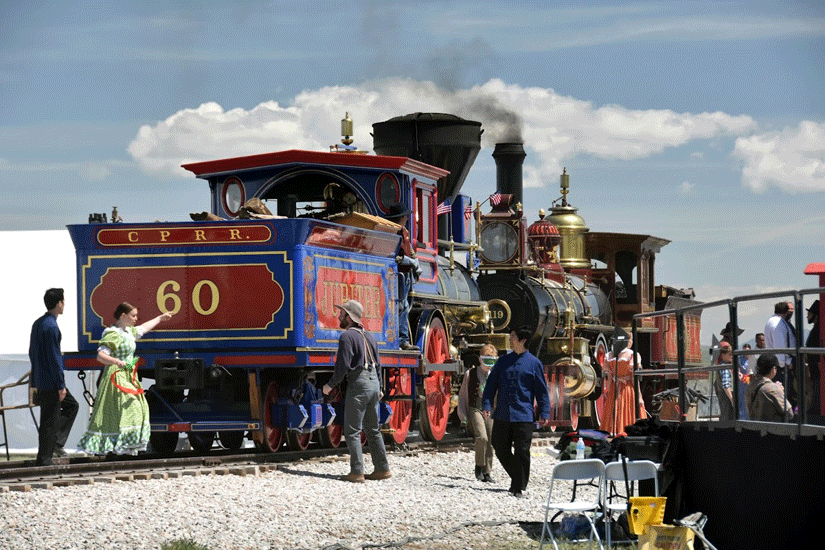
Central Pacific 60 and Union Pacific 119 Replicas at a Driving of the Last Spike Reenactment Celebration May 2019 - Golden Spike National Historical Park Utah
View additional articles like this one in the Trains N Scale™ Models and Prototypes Blog.
Recent Posts
- » A Quick Look: InterMountain Fox Valley Red Caboose Autoracks Review
- » A Quick Look: Athearn 2293 N UPS Wedge Trailers and Dolly
- » A Quick Look: Atlas N 1993 Ford Explorer SUV 5th Run Review
- » A Quick Look: Eastern Seaboard Models N Metal Wheel-Sets Review
- » A Quick Look: Jacksonville Terminal JTC NSC 53' Well Cars Review
